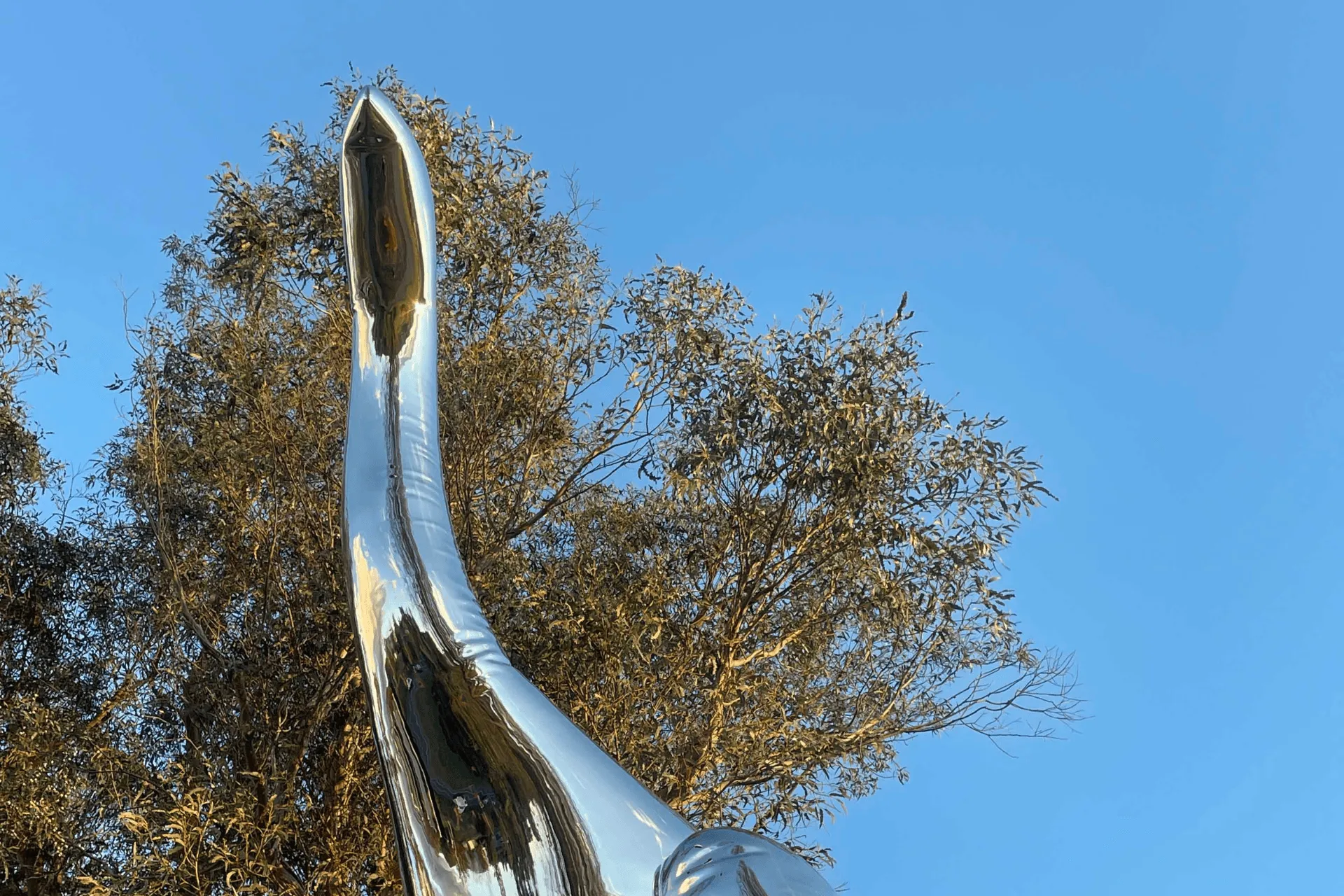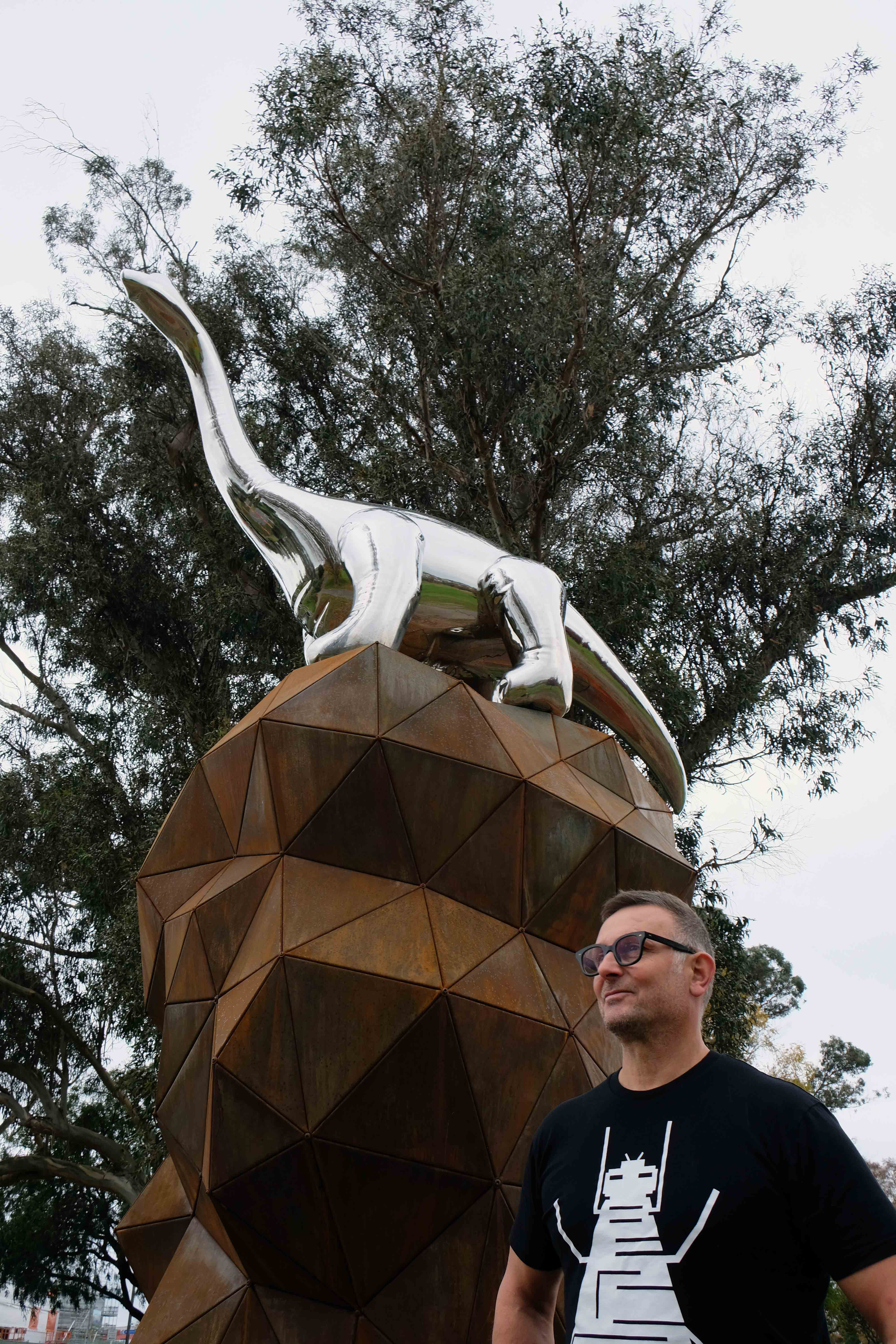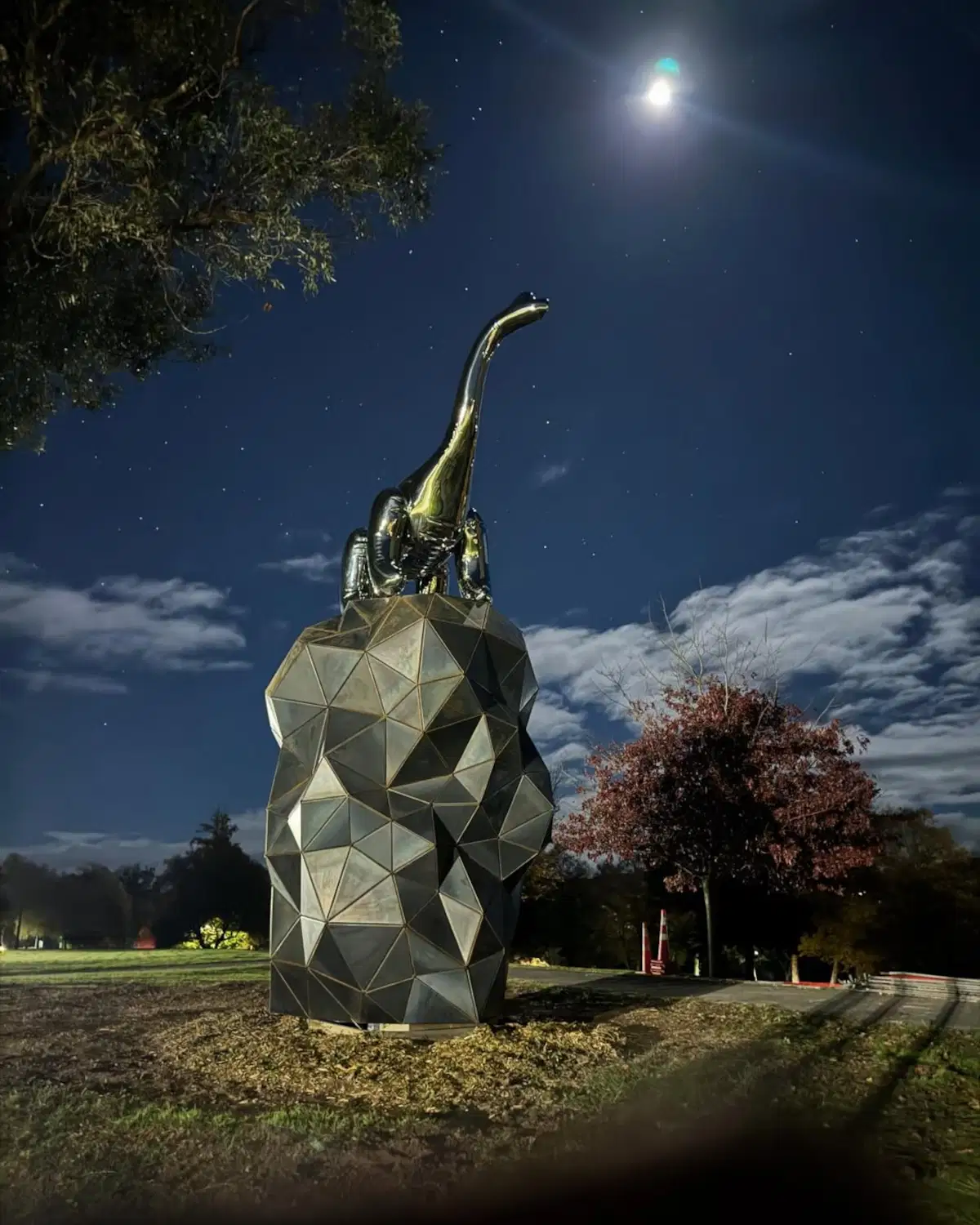A Dinosaur At The Edge Of Imagination
Perched atop a jagged, volcanic plinth, a sci-fi-meets-prehistoric creature now towers over Riverside Park in Taupō.

Take a trip around the motu as we explore arts initiatives that contribute to the cultural vibrancy of local creative communities and the wider arts ecosystem across Aotearoa in our new series – Road Trip.
Public art - at its best - opens up a space, not only in the landscape, but in the mind.
It alters the rhythm of daily life, making us pause, recalibrate, and see differently. It brings forward what is hidden: layers of geology, histories, cultural tensions, and the soft, unexpected joy of wonder.
In Taupō, this kind of art has arrived in the form of a dinosaur.
Gregor Kregar’s Boom Boom stands at once inside and outside of time. Perched atop a jagged, volcanic plinth, this towering, sci-fi-meets-prehistory creature appears both futuristic and ancient, foreign and familiar.
It doesn’t just decorate the park, it punctuates it, casting a strange new silhouette into the landscape and the cultural imagination.
Seven years in the making - Boom Boom is the inaugural gesture in Taupō’s 10-year vision for a sculpture trail through Riverside Park; a signal flare announcing that something different is possible here. It’s part monument, part interruption - offering the kind of rupture that creates room for new thoughts to gather. It invites reflection, sparks memes, and begins conversations, about place, about play, about the role of culture in the public sphere.
Dinosaur with depth

Kregar’s work has long hovered in the space between wit and weight, between whimsy and inquiry. With Boom Boom, he brings those tendencies to full height.
Shaped from reflective steel, the dinosaur plays on the familiar - resembling a poolside inflatable - while being impossibly solid. It balances levity with geological gravity. The plinth on which it stands echoes the volcanic foundations of the region, grounding its metallic skin in the deep time of the whenua.
“For me, it’s about that sense of wonder and surprise,” Kregar details. “You don’t expect to see a dinosaur in the middle of Taupō, but that’s the point.
"It’s an invitation to think differently about public space. To imagine, to play.”
But for Kregar, play is never without purpose. It’s an artistic method and a sideways entry into bigger ideas. His mirrored surfaces and unexpected forms draw people in, disarm resistance, and dismantle hierarchies of access.
You don’t need a degree in art history to feel something. That accessibility is a political act in itself.
“A lot of public art isn’t accessible,” he says. “And I think it’s important to have that entry point, to make work that doesn’t just sit on the intellectual top shelf. That’s what public art should do: create points of connection.”
A long, glossy journey
Boom Boom didn’t drop from the sky. It was commissioned through a national call-out and weathered multiple shifts: location changes, council turnover, a global pandemic. The final result is a sculpture as much about perseverance as play.
“Public art is really satisfying,” Kregar reflects, “but also controversial and often difficult to realise. You have to deal with architects, engineers, safety regulations.”
That resistance is folded into the form. The tension between delight and difficulty gives Boom Boom its edge - quite literally, in the sharp, faceted plinth that echoes tectonic energy beneath the Central Plateau.
The dinosaur - inspired by the long-necked sauropods that once roamed Aotearoa - is more than ornamental. It speaks to extinction and endurance, to the strange poetry of what lingers in imagination long after it’s gone.
What at first appears like a glossy, oversized toy slowly reveals itself as a story about deep time, cultural layering, and the politics of place. Kregar takes a pool float and makes it hold the past. He makes a joke and turns it into a mirror.
The art of engagement
But perhaps the most striking thing about Boom Boom is what it catalysed. It didn’t end at installation - it began there. The sculpture has become a protagonist in Taupō life: going viral in news media across the globe, gaining a Facebook personality, being photoshopped into real estate ads and tourism promos, serving up dry wit and local charm to anyone willing to engage. People who might never walk into a gallery now talk about public art on the street.
“You make the work, but you don’t control how people respond to it,” Kregar remarks. “That space of interpretation, of humour and imagination - that’s where the real magic is.”
This is art not as object but as ecosystem. Not a conclusion, but an opening. What matters is not just what it is, but what it does. How it moves through the lives of people who didn’t ask for it, but now claim it as part of their place.
Tourism leaders have taken note. “No $200,000 ad campaign could have matched” the media value of Boom Boom’s debut, they say. But the real value isn’t in the headlines. It’s in the quiet shift happening under the surface: the redefinition of Taupō not only as a site of leisure, but as a site of cultural ambition.
Reflecting us back to ourselves
At its heart, Boom Boom is a mirror. Quite literally. You see yourself reflected in its stainless-steel body, but also metaphorically. The work shows Taupō back to itself: playful and serious, bold and thoughtful, full of contradictions and full of life.
“There’s a seriousness to it,” Kregar says. “It’s not just a joke. There’s something about the permanence of these extinct creatures, how they loom large in the imagination. It’s humorous, but also a little bit haunting.”
This is how public art endures. Not just through permanence, but through resonance. By offering not a final message but an ongoing invitation.
A new chapter for Taupō
As the first step in an evolving sculpture park, Boom Boom is a kind of provocation.
It asks what public space can be, and who it is for. It offers a different kind of monument: one that looks forward as much as back, and that insists imagination is infrastructure.
“I think it’s important,” says Kregar. “Art in public space, especially in smaller towns, can have a big impact. It’s not just decoration. It shapes how people feel about where they live, and how they move through that space.”
Taupō, long celebrated for geothermal spectacle and lakefront serenity, is now asserting itself as a place where ideas belong - not just adventures. With Boom Boom leading the way, the town becomes a canvas for ambitious cultural imagination. A place where public art is not an afterthought but a core part of identity. Where culture is held as important as sport, as leisure, as tourism, and maybe, quietly, as the thing that connects them all.

Boom Boom by Gregor Kregar is now on permanent display in Taupō. For updates and dinosaur gossip, check out the community-run Facebook page HERE.